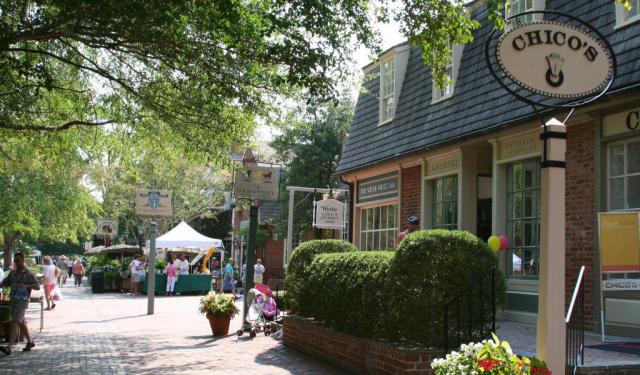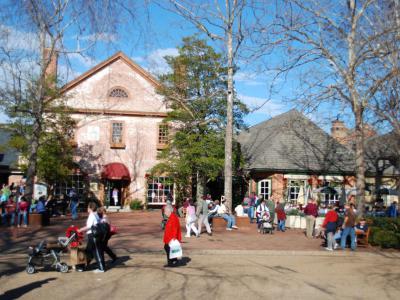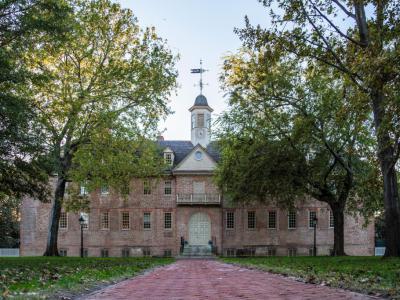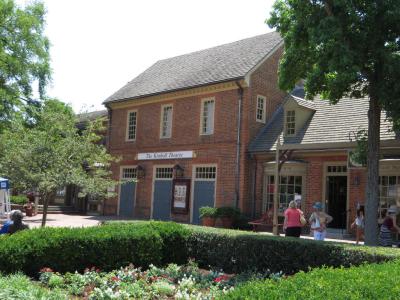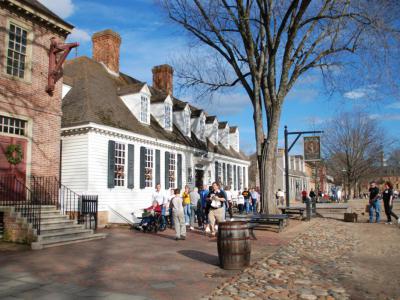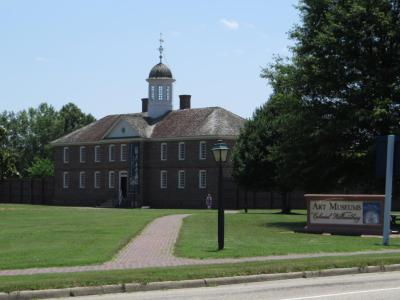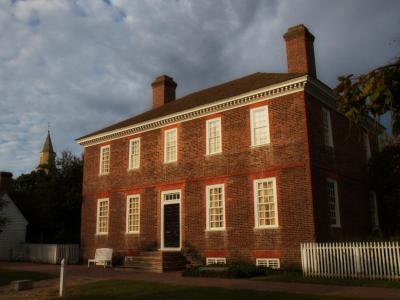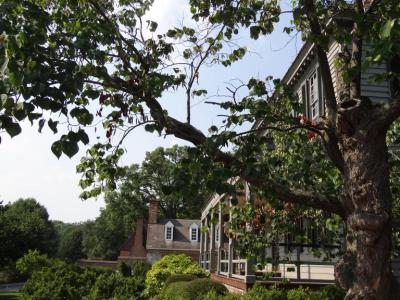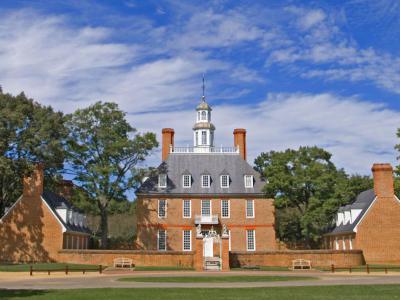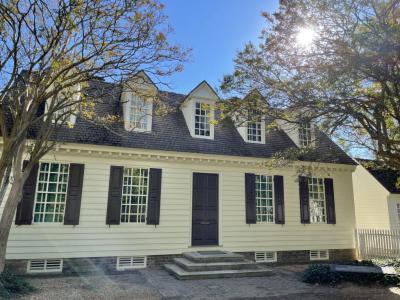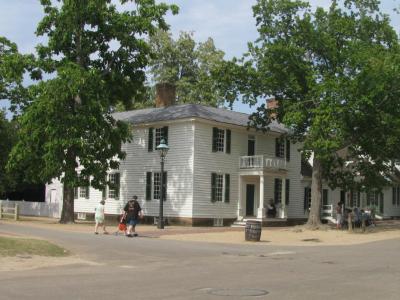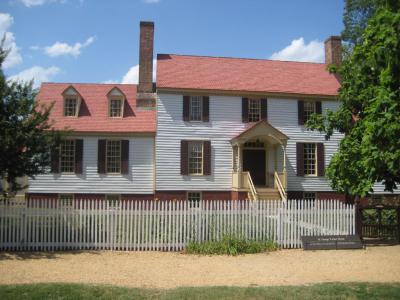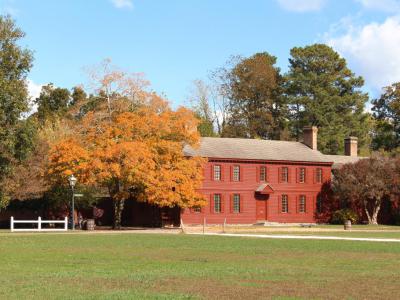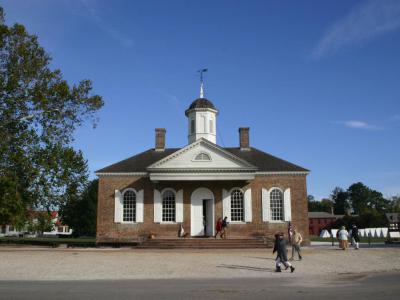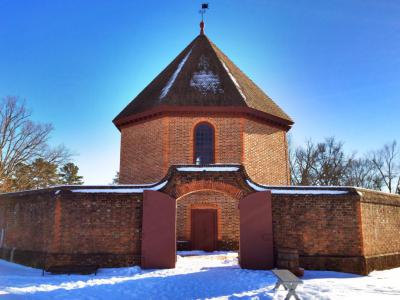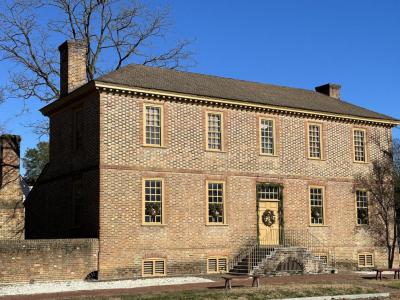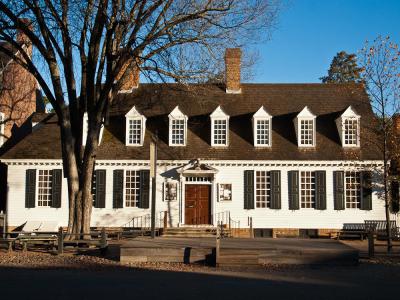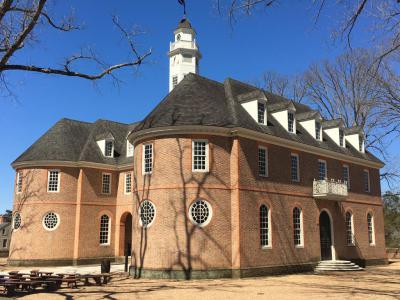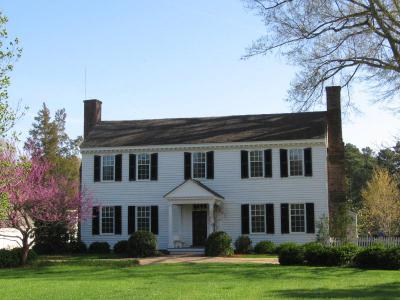Williamsburg Introduction Walking Tour (Self Guided), Williamsburg
Williamsburg, an independent city in Virginia, was founded by English settlers in 1632 – originally as a fortified settlement called Middle Plantation, on the high ground between the James and York rivers.
The local College of William & Mary, established in 1693, is the second-oldest institution of higher education in the United States. Its alumni include three US presidents as well as many other important figures in the nation's early history. The iconic Wren Building on campus is a symbol of the college's enduring legacy.
From 1699 to 1780, the town functioned as the capital of the Colony and Commonwealth of Virginia, at which point it was renamed Williamsburg in honor of King William III of England, befitting its newly elevated status.
Several political events that took place in Williamsburg during that period, notably the Gunpowder Incident of 1775 (over the gunpowder stored in the Williamsburg magazine), led to the American Revolution. On July 25, 1776, the Declaration of Independence resounded in town, amid cannon fire and illuminations.
After losing its status as Virginia's capital to Richmond in 1780, Williamsburg faced a decline, attributed partly to its location away from major waterways crucial for transportation. In 1862, during the Peninsula Campaign of the Civil War, Williamsburg became a battleground. Despite Union occupation, from May 1862 to September 1865, marked by destructive incidents like the burning of the College Building, the town endured.
In the early 20th century, Williamsburg was a quiet place, overshadowed by its more bustling Virginia counterparts. However, the creation of Colonial Williamsburg, supported by John D Rockefeller Junior and Abby Aldrich Rockefeller, revitalized the town's historic core. Today, this living museum is Virginia's premier tourist destination, attracting annually more than four million visitors.
Here, they can explore landmarks such as the Abby Aldrich Rockefeller Folk Art Museum, the Bruton Parish Episcopal Church, and the George Wythe House.
Further exploration reveals the Robert Carter House, Governor's Palace, Thomas Everard House, James Geddy House, Saint George Tucker House, Peyton Randolph House, Courthouse, The Magazine, Ludwell-Paradise House, Raleigh Tavern, Capitol Building, and Bassett Hall, each offering a glimpse into Williamsburg's storied past.
From its colonial-era architecture to its vibrant cultural scene, Williamsburg invites visitors to step back in time and immerse themselves in the history and heritage of America's early days. Join us on this self-guided tour and discover the stories that shaped the nation.
The local College of William & Mary, established in 1693, is the second-oldest institution of higher education in the United States. Its alumni include three US presidents as well as many other important figures in the nation's early history. The iconic Wren Building on campus is a symbol of the college's enduring legacy.
From 1699 to 1780, the town functioned as the capital of the Colony and Commonwealth of Virginia, at which point it was renamed Williamsburg in honor of King William III of England, befitting its newly elevated status.
Several political events that took place in Williamsburg during that period, notably the Gunpowder Incident of 1775 (over the gunpowder stored in the Williamsburg magazine), led to the American Revolution. On July 25, 1776, the Declaration of Independence resounded in town, amid cannon fire and illuminations.
After losing its status as Virginia's capital to Richmond in 1780, Williamsburg faced a decline, attributed partly to its location away from major waterways crucial for transportation. In 1862, during the Peninsula Campaign of the Civil War, Williamsburg became a battleground. Despite Union occupation, from May 1862 to September 1865, marked by destructive incidents like the burning of the College Building, the town endured.
In the early 20th century, Williamsburg was a quiet place, overshadowed by its more bustling Virginia counterparts. However, the creation of Colonial Williamsburg, supported by John D Rockefeller Junior and Abby Aldrich Rockefeller, revitalized the town's historic core. Today, this living museum is Virginia's premier tourist destination, attracting annually more than four million visitors.
Here, they can explore landmarks such as the Abby Aldrich Rockefeller Folk Art Museum, the Bruton Parish Episcopal Church, and the George Wythe House.
Further exploration reveals the Robert Carter House, Governor's Palace, Thomas Everard House, James Geddy House, Saint George Tucker House, Peyton Randolph House, Courthouse, The Magazine, Ludwell-Paradise House, Raleigh Tavern, Capitol Building, and Bassett Hall, each offering a glimpse into Williamsburg's storied past.
From its colonial-era architecture to its vibrant cultural scene, Williamsburg invites visitors to step back in time and immerse themselves in the history and heritage of America's early days. Join us on this self-guided tour and discover the stories that shaped the nation.
How it works: Download the app "GPSmyCity: Walks in 1K+ Cities" from Apple App Store or Google Play Store to your mobile phone or tablet. The app turns your mobile device into a personal tour guide and its built-in GPS navigation functions guide you from one tour stop to next. The app works offline, so no data plan is needed when traveling abroad.
Williamsburg Introduction Walking Tour Map
Guide Name: Williamsburg Introduction Walking Tour
Guide Location: USA » Williamsburg (See other walking tours in Williamsburg)
Guide Type: Self-guided Walking Tour (Sightseeing)
# of Attractions: 19
Tour Duration: 3 Hour(s)
Travel Distance: 3.4 Km or 2.1 Miles
Author: DanaOffice
Sight(s) Featured in This Guide:
Guide Location: USA » Williamsburg (See other walking tours in Williamsburg)
Guide Type: Self-guided Walking Tour (Sightseeing)
# of Attractions: 19
Tour Duration: 3 Hour(s)
Travel Distance: 3.4 Km or 2.1 Miles
Author: DanaOffice
Sight(s) Featured in This Guide:
- Merchants Square
- Wren Building at the College of William and Mary
- Kimball Theatre
- Duke of Gloucester Street
- Abby Aldrich Rockefeller Folk Art Museum
- Bruton Parish Episcopal Church
- George Wythe House
- Robert Carter House
- Governor's Palace
- Thomas Everard House
- James Geddy House
- St. George Tucker House
- Peyton Randolph House
- Courthouse
- The Magazine
- Ludwell-Paradise House
- Raleigh Tavern
- Capitol Building
- Bassett Hall
1) Merchants Square
Merchants Square stands as a unique blend of historical charm and modern convenience in Williamsburg. Conceived in 1927 by John D. Rockefeller Jr. and Reverend W. A. R. Goodwin, this meticulously planned shopping district is a 20th-century interpretation of an 18th-century-style retail village, listed on the National Register of Historic Places. Designed by William G. Perry, chief architect of the Williamsburg Restoration, Merchants Square represents one of the earliest planned shopping districts in the United States, if not the first.
Situated along Duke of Gloucester Street (DoG St.) opposite The College of William & Mary’s campus, Merchants Square seamlessly integrates into the colonial-era ambiance of Williamsburg. Its architectural design harmonizes with the restoration's character, featuring small shops and storefronts reminiscent of the colonial era. To maintain historical accuracy, all telephone wires were placed underground, while modern amenities such as air-conditioning ducts and garage equipment were discreetly concealed with shrubs and plantings, ensuring that visitors are transported back in time as they stroll through the square.
Today, Merchants Square boasts over 40 shops and restaurants, offering a diverse array of shopping and dining experiences. Beyond retail therapy and culinary delights, the square serves as a vibrant community hub, hosting seasonal concerts, farmers' markets, and special movie screenings. Whether visitors seek a taste of history, a leisurely shopping spree, or a lively cultural experience, Merchants Square offers a delightful blend of past and present, inviting visitors to immerse themselves in the rich heritage of Williamsburg while enjoying modern-day amenities.
Situated along Duke of Gloucester Street (DoG St.) opposite The College of William & Mary’s campus, Merchants Square seamlessly integrates into the colonial-era ambiance of Williamsburg. Its architectural design harmonizes with the restoration's character, featuring small shops and storefronts reminiscent of the colonial era. To maintain historical accuracy, all telephone wires were placed underground, while modern amenities such as air-conditioning ducts and garage equipment were discreetly concealed with shrubs and plantings, ensuring that visitors are transported back in time as they stroll through the square.
Today, Merchants Square boasts over 40 shops and restaurants, offering a diverse array of shopping and dining experiences. Beyond retail therapy and culinary delights, the square serves as a vibrant community hub, hosting seasonal concerts, farmers' markets, and special movie screenings. Whether visitors seek a taste of history, a leisurely shopping spree, or a lively cultural experience, Merchants Square offers a delightful blend of past and present, inviting visitors to immerse themselves in the rich heritage of Williamsburg while enjoying modern-day amenities.
2) Wren Building at the College of William and Mary (must see)
The Wren Building at the College of William and Mary stands as a testament to the institution's rich history and enduring legacy. Constructed in 1695, it is the oldest active educational building in the United States and forms an integral part of the college's "Ancient Campus" alongside the Brafferton and President's House. Originally built of red brick in the Flemish and English Bond style typical of 17th- and 18th-century Williamsburg, the Wren Building has undergone several reconstructions, most notably after a fire in 1705 and a subsequent reconstruction in 1732. This historic edifice was designated a National Historic Landmark in 1960, recognizing its architectural significance and cultural importance.
Within the Wren Building's venerable walls are housed classrooms, offices, a refectory known as the Great Hall, a kitchen, and a chapel. The chapel, added as a south wing in 1732, features a crypt beneath where several notable Virginians are laid to rest, including royal governor the 4th Baron Botetourt and Speaker of the House of Burgesses Sir John Randolph. As the oldest extant building constructed for use by a college or university in the United States, the Wren Building holds a special place in American academic history, preceding even Massachusetts Hall at Harvard University.
Today, the Wren Building remains a vibrant center of academic and cultural life at the College of William and Mary. The first floor is open to visitors, inviting them to explore its historic halls and corridors. Student-led campus tours offer insights into the building's storied past, sharing anecdotes and historical anecdotes about the college. Additionally, visitors can attend free organ concerts in the chapel, view exhibitions at the Muscarelle Museum of Art, and admire sculptures scattered throughout the campus, all while experiencing the timeless charm and academic excellence embodied by the Wren Building.
Within the Wren Building's venerable walls are housed classrooms, offices, a refectory known as the Great Hall, a kitchen, and a chapel. The chapel, added as a south wing in 1732, features a crypt beneath where several notable Virginians are laid to rest, including royal governor the 4th Baron Botetourt and Speaker of the House of Burgesses Sir John Randolph. As the oldest extant building constructed for use by a college or university in the United States, the Wren Building holds a special place in American academic history, preceding even Massachusetts Hall at Harvard University.
Today, the Wren Building remains a vibrant center of academic and cultural life at the College of William and Mary. The first floor is open to visitors, inviting them to explore its historic halls and corridors. Student-led campus tours offer insights into the building's storied past, sharing anecdotes and historical anecdotes about the college. Additionally, visitors can attend free organ concerts in the chapel, view exhibitions at the Muscarelle Museum of Art, and admire sculptures scattered throughout the campus, all while experiencing the timeless charm and academic excellence embodied by the Wren Building.
3) Kimball Theatre
Situated in the heart of Merchants Square, the Kimball Theatre stands as a vibrant hub for entertainment in Williamsburg. Boasting a diverse array of offerings, this historic venue hosts a dynamic mix of current films and live performances that cater to a wide range of interests. From captivating Colonial Williamsburg interpretations to spirited jazz ensembles featuring talented students from the College of William and Mary, the Kimball Theatre offers something for everyone. Its central location makes it a focal point for community activities, serving as a gathering place where locals and visitors alike come together to enjoy enriching cultural experiences.
The Kimball Theatre's rich history adds to its allure, tracing its roots back to January 12, 1933, when its curtain first rose to reveal a performance of "The Recruiting Officer" by players from the College of William and Mary. This inaugural production marked the beginning of a longstanding tradition of theatrical excellence in the region. On opening night, attendees were treated to a diverse program that included not only live performances but also a range of cinematic delights, from newsreels to Mickey Mouse cartoons. The atmosphere was electric, with searchlights illuminating the sky, airplanes soaring overhead, and fireworks lighting up the night.
Today, the Kimball Theatre continues to honor its storied past while embracing the present with innovative programming that reflects the diverse interests of the community. Collaborations with the College of William and Mary, local organizations, and Colonial Williamsburg ensure that the theatre remains deeply rooted in the cultural fabric of the region. Whether you're in the mood for a thought-provoking film screening, a captivating live performance, or a glimpse into Williamsburg's rich history, the Kimball Theatre invites you to step inside and embark on a memorable journey of entertainment and discovery.
The Kimball Theatre's rich history adds to its allure, tracing its roots back to January 12, 1933, when its curtain first rose to reveal a performance of "The Recruiting Officer" by players from the College of William and Mary. This inaugural production marked the beginning of a longstanding tradition of theatrical excellence in the region. On opening night, attendees were treated to a diverse program that included not only live performances but also a range of cinematic delights, from newsreels to Mickey Mouse cartoons. The atmosphere was electric, with searchlights illuminating the sky, airplanes soaring overhead, and fireworks lighting up the night.
Today, the Kimball Theatre continues to honor its storied past while embracing the present with innovative programming that reflects the diverse interests of the community. Collaborations with the College of William and Mary, local organizations, and Colonial Williamsburg ensure that the theatre remains deeply rooted in the cultural fabric of the region. Whether you're in the mood for a thought-provoking film screening, a captivating live performance, or a glimpse into Williamsburg's rich history, the Kimball Theatre invites you to step inside and embark on a memorable journey of entertainment and discovery.
4) Duke of Gloucester Street
Duke of Gloucester Street offers visitors an immersive journey through time, beckoning them to experience life as it was in the 18th century. Lined with meticulously preserved colonial buildings, this historic thoroughfare serves as the bustling heart of the city's Historic Area. As visitors stroll down Duke of Gloucester Street, they are transported back in time, encountering scenes straight out of a living history book. From the clang of blacksmiths' hammers in open-air workshops to the sight of costumed interpreters reenacting daily life, every step along this storied street resonates with the rich tapestry of America's colonial past.
Named in honor of William, Duke of Gloucester, the son of Queen Anne, Duke of Gloucester Street holds a significant place in American history. The street was widened from a humble horse path to a grand ninety-nine-foot-wide thoroughfare, connecting the College of William and Mary to the new capitol building. Its designation as the main street of Williamsburg in 1699 by Virginia's General Assembly cemented its status as a cherished symbol of colonial heritage. President Franklin D. Roosevelt, during a visit to Williamsburg in 1934, aptly described Duke of Gloucester Street as "the most historic avenue in all America," acknowledging its significance in shaping the nation's narrative.
Throughout its storied history, Duke of Gloucester Street has welcomed a parade of notable figures, from founding fathers like George Washington and Thomas Jefferson to modern-day leaders such as Bill Clinton and Ronald Reagan. Their footsteps echo alongside those of colonial luminaries like Patrick Henry and James Madison, lending an aura of significance to every corner of the street.
Named in honor of William, Duke of Gloucester, the son of Queen Anne, Duke of Gloucester Street holds a significant place in American history. The street was widened from a humble horse path to a grand ninety-nine-foot-wide thoroughfare, connecting the College of William and Mary to the new capitol building. Its designation as the main street of Williamsburg in 1699 by Virginia's General Assembly cemented its status as a cherished symbol of colonial heritage. President Franklin D. Roosevelt, during a visit to Williamsburg in 1934, aptly described Duke of Gloucester Street as "the most historic avenue in all America," acknowledging its significance in shaping the nation's narrative.
Throughout its storied history, Duke of Gloucester Street has welcomed a parade of notable figures, from founding fathers like George Washington and Thomas Jefferson to modern-day leaders such as Bill Clinton and Ronald Reagan. Their footsteps echo alongside those of colonial luminaries like Patrick Henry and James Madison, lending an aura of significance to every corner of the street.
5) Abby Aldrich Rockefeller Folk Art Museum (must see)
The Art Museums of Colonial Williamsburg offer a captivating journey through American history and culture, showcasing an extensive collection of fine and decorative arts from the 17th to the 19th centuries. Comprising the DeWitt Wallace Decorative Arts Museum (DWDAM) and the Abby Aldrich Rockefeller Folk Art Museum (AARFAM), this cultural enclave provides visitors with a multifaceted exploration of artistic expression in early America. Originally established in 1985, the museum has undergone expansions and renovations, including a forthcoming enhancement slated for 2019 with a new street-level entrance.
The DeWitt Wallace Decorative Arts Museum immerses visitors in the elegance and craftsmanship of British and American fine and decorative arts spanning the period from 1670 to 1840. From exquisite furniture and paintings to silverware and ceramics, the museum's diverse collections offer insights into the cultural and social fabric of colonial America. Attendees can also explore numismatics, textiles, weaponry, and more from the Colonial Williamsburg collection, with opportunities to engage in hands-on activities, attend lectures, and enjoy musical events in the Hennage Auditorium.
Adjacent to the DeWitt Wallace Decorative Arts Museum, the Abby Aldrich Rockefeller Folk Art Museum celebrates the vibrancy and authenticity of American folk art. Founded as the nation's first continually operated museum dedicated to folk art, it owes its inception to the generosity of Abby Aldrich Rockefeller and her husband, John D. Rockefeller Jr. Visitors can admire colorful and whimsical creations by amateur artisans, gaining a deeper appreciation for this cherished cultural heritage.
The DeWitt Wallace Decorative Arts Museum immerses visitors in the elegance and craftsmanship of British and American fine and decorative arts spanning the period from 1670 to 1840. From exquisite furniture and paintings to silverware and ceramics, the museum's diverse collections offer insights into the cultural and social fabric of colonial America. Attendees can also explore numismatics, textiles, weaponry, and more from the Colonial Williamsburg collection, with opportunities to engage in hands-on activities, attend lectures, and enjoy musical events in the Hennage Auditorium.
Adjacent to the DeWitt Wallace Decorative Arts Museum, the Abby Aldrich Rockefeller Folk Art Museum celebrates the vibrancy and authenticity of American folk art. Founded as the nation's first continually operated museum dedicated to folk art, it owes its inception to the generosity of Abby Aldrich Rockefeller and her husband, John D. Rockefeller Jr. Visitors can admire colorful and whimsical creations by amateur artisans, gaining a deeper appreciation for this cherished cultural heritage.
6) Bruton Parish Episcopal Church (must see)
Bruton Parish Episcopal Church stands as a venerable testament to colonial-era faith and architecture in Williamsburg. Its origins trace back to 1715 when it replaced an earlier, smaller structure. At the time, the Church of England held sway as the established church in the American colonies, and the General Assembly funded pews for esteemed individuals such as the governor, council, and burgesses. Notably, the church's cruciform design with transepts, a pioneering feature in Virginia, was conceptualized by Royal Governor Alexander Spotswood.
Throughout its storied history, Bruton Parish has been frequented by distinguished figures of American history, as evidenced by the engraved name plates adorning its box pews. Among the luminaries who worshiped within its hallowed halls are George Washington, Thomas Jefferson, Patrick Henry, James Madison, and many others. The church's original bell, cast in 1761, still resonates with echoes of the past, having tolled during pivotal moments such as the signing of the Declaration of Independence in 1776 and the treaty marking the end of the American Revolution in 1783.
Despite its historical significance, Bruton Parish remains an active Episcopal church, hosting regular services for its congregation. However, it warmly welcomes visitors seeking to explore its rich heritage at other times, with volunteers on hand to offer insights into its architectural and historical nuances. Additionally, visitors have the opportunity to attend evening candlelight concerts, a captivating experience that further enhances the church's timeless allure. Admission to both the church and concerts is free, inviting individuals to immerse themselves in the spiritual and cultural legacy of this cherished Williamsburg landmark.
Throughout its storied history, Bruton Parish has been frequented by distinguished figures of American history, as evidenced by the engraved name plates adorning its box pews. Among the luminaries who worshiped within its hallowed halls are George Washington, Thomas Jefferson, Patrick Henry, James Madison, and many others. The church's original bell, cast in 1761, still resonates with echoes of the past, having tolled during pivotal moments such as the signing of the Declaration of Independence in 1776 and the treaty marking the end of the American Revolution in 1783.
Despite its historical significance, Bruton Parish remains an active Episcopal church, hosting regular services for its congregation. However, it warmly welcomes visitors seeking to explore its rich heritage at other times, with volunteers on hand to offer insights into its architectural and historical nuances. Additionally, visitors have the opportunity to attend evening candlelight concerts, a captivating experience that further enhances the church's timeless allure. Admission to both the church and concerts is free, inviting individuals to immerse themselves in the spiritual and cultural legacy of this cherished Williamsburg landmark.
7) George Wythe House
The George Wythe House, nestled on the Palace Green in Colonial Williamsburg, is a historic gem steeped in significance. Constructed in the 1750s, this distinguished residence was the cherished abode of George Wythe, a notable figure in American history renowned as a signer of the Declaration of Independence and a pioneer in the realm of jurisprudence. Designated as a National Historic Landmark on April 15, 1970, the Wythe House stands as a testament to the colonial architectural elegance of its era.
Originally belonging to George Wythe's father-in-law, Richard Taliaferro, the house was meticulously crafted between 1752 and 1754. The architectural finesse of the Wythe House is evident in its symmetrical facade, constructed with red brick adorned with white woodwork. Its hip roof, supported by brick chimneys and embellished with a modillion cornice, exudes timeless charm and sophistication.
Stepping through the entrance adorned with a transom window, visitors are transported to a bygone era of colonial splendor. The interior layout, characterized by a central passage and double-pile plan, offers a glimpse into the daily life of its esteemed inhabitants. From the meticulously furnished parlor and dining room to the cozy bedrooms and Wythe's office, each room tells a captivating story of colonial life in Williamsburg. With its beveled water table, Flemish bond walls, and pine floors, the Wythe House exemplifies the architectural integrity and craftsmanship of its time.
Ascending to the second floor, visitors encounter a similar layout adorned with four bedrooms, each boasting a fireplace and showcasing the meticulous attention to detail characteristic of colonial-era construction.
Originally belonging to George Wythe's father-in-law, Richard Taliaferro, the house was meticulously crafted between 1752 and 1754. The architectural finesse of the Wythe House is evident in its symmetrical facade, constructed with red brick adorned with white woodwork. Its hip roof, supported by brick chimneys and embellished with a modillion cornice, exudes timeless charm and sophistication.
Stepping through the entrance adorned with a transom window, visitors are transported to a bygone era of colonial splendor. The interior layout, characterized by a central passage and double-pile plan, offers a glimpse into the daily life of its esteemed inhabitants. From the meticulously furnished parlor and dining room to the cozy bedrooms and Wythe's office, each room tells a captivating story of colonial life in Williamsburg. With its beveled water table, Flemish bond walls, and pine floors, the Wythe House exemplifies the architectural integrity and craftsmanship of its time.
Ascending to the second floor, visitors encounter a similar layout adorned with four bedrooms, each boasting a fireplace and showcasing the meticulous attention to detail characteristic of colonial-era construction.
8) Robert Carter House
Constructed by Robert "King" Carter, a prominent figure in colonial Virginia, the Robert Carter House became the residence of his grandson, Robert Carter III, and his large family in 1761. As one of the original eighty-eight buildings in Colonial Williamsburg, the house occupies a significant place in the historic fabric of the region, overlooking the east side of Palace Green.
Visitors to the Robert Carter House have the opportunity to delve into Colonial Williamsburg's multifaceted investigative processes used to document, understand, preserve, and furnish this historic site. Through immersive experiences and interpretive programs, guests can explore the life and history of the Carter family, as well as the stories of the enslaved and free individuals who worked and labored within its walls. The house serves as a window into the complex social dynamics and economic structures of colonial Virginia, shedding light on both the privileges and challenges faced by its inhabitants.
Throughout its storied history, the Robert Carter House has witnessed various occupants, including members of the Carter family and even Governor Robert Dinwiddie during renovations of the nearby Governor's Palace in the mid-18th century.
Visitors to the Robert Carter House have the opportunity to delve into Colonial Williamsburg's multifaceted investigative processes used to document, understand, preserve, and furnish this historic site. Through immersive experiences and interpretive programs, guests can explore the life and history of the Carter family, as well as the stories of the enslaved and free individuals who worked and labored within its walls. The house serves as a window into the complex social dynamics and economic structures of colonial Virginia, shedding light on both the privileges and challenges faced by its inhabitants.
Throughout its storied history, the Robert Carter House has witnessed various occupants, including members of the Carter family and even Governor Robert Dinwiddie during renovations of the nearby Governor's Palace in the mid-18th century.
9) Governor's Palace (must see)
The Governor's Palace, a symbol of colonial authority and opulence, stands as a testament to Virginia's rich history in Williamsburg. Constructed between 1706 and 1722, this grand residence served as the official dwelling for the royal governors of colonial Virginia throughout much of the eighteenth century. Over the years, it housed seven royal governors and two post-colonial governors, including notable figures like Patrick Henry and Thomas Jefferson. Designed to impress visitors with its imposing architecture and lavish interiors, the Governor's Palace was a symbol of power and prestige during its heyday.
The historical significance of the Governor's Palace extends beyond its role as a residence for colonial dignitaries. It played a pivotal role in shaping Virginia's colonial history and witnessed significant events that shaped the destiny of the nation. During the American Revolutionary War, the Palace served as a hospital for wounded American soldiers during the decisive Battle of Yorktown in 1781. Despite its grandeur, tragedy struck later that year when the Palace was consumed by fire, marking the end of an era.
In the aftermath of the fire, the site of the Governor's Palace passed into the hands of the College of William and Mary, which erected educational buildings on the property. However, the legacy of the Palace lived on through its historical significance and the memories of its illustrious residents. In 1928, the Colonial Williamsburg Foundation acquired the property, embarking on a mission to preserve and restore this iconic landmark.
The historical significance of the Governor's Palace extends beyond its role as a residence for colonial dignitaries. It played a pivotal role in shaping Virginia's colonial history and witnessed significant events that shaped the destiny of the nation. During the American Revolutionary War, the Palace served as a hospital for wounded American soldiers during the decisive Battle of Yorktown in 1781. Despite its grandeur, tragedy struck later that year when the Palace was consumed by fire, marking the end of an era.
In the aftermath of the fire, the site of the Governor's Palace passed into the hands of the College of William and Mary, which erected educational buildings on the property. However, the legacy of the Palace lived on through its historical significance and the memories of its illustrious residents. In 1928, the Colonial Williamsburg Foundation acquired the property, embarking on a mission to preserve and restore this iconic landmark.
10) Thomas Everard House
The Thomas Everard House stands as a testament to the wealth and influence of Thomas Everard, a prominent planter and civic leader in colonial Williamsburg. Constructed in 1718, it ranks among the oldest houses in the area and offers a glimpse into the lifestyle of the colonial elite. The house, with its five-bay, timber-framed structure and hand-split weatherboard exterior, exudes a sense of modest elegance that reflects the architectural trends of its time.
Originally built by John Brush, the first keeper of Williamsburg's Magazine, the Everard House underwent several modifications over the centuries while retaining its essential character. Its interior is furnished with authentic 18th-century antiques, providing visitors with a window into the past. Notable features include a center-passage plan layout, indicative of fashionable architectural styles of the era, and a finely crafted staircase adorned with elaborately turned balusters and ornate carving.
Meticulously restored to its early appearance, the Everard House showcases the painstaking efforts to preserve its historical integrity. Recent restoration work has uncovered original wallpaper fragments and patches of paint, offering valuable insights into the house's original interior decor. The yard surrounding the house features original brick paving discovered during archaeological excavations, adding to its authenticity.
Originally built by John Brush, the first keeper of Williamsburg's Magazine, the Everard House underwent several modifications over the centuries while retaining its essential character. Its interior is furnished with authentic 18th-century antiques, providing visitors with a window into the past. Notable features include a center-passage plan layout, indicative of fashionable architectural styles of the era, and a finely crafted staircase adorned with elaborately turned balusters and ornate carving.
Meticulously restored to its early appearance, the Everard House showcases the painstaking efforts to preserve its historical integrity. Recent restoration work has uncovered original wallpaper fragments and patches of paint, offering valuable insights into the house's original interior decor. The yard surrounding the house features original brick paving discovered during archaeological excavations, adding to its authenticity.
11) James Geddy House
The James Geddy House, a historic gem nestled on the Palace Green, stands as a testament to the town's rich colonial heritage. Constructed circa 1762 by James Geddy Jr., a prominent silversmith of the time, this two-story central-passage house is one of the oldest in Virginia and Williamsburg. Beyond its significance as a residence, the Geddy House served as the hub for the Geddy family's various business ventures, with a rear entrance doubling as a retail shop.
James Geddy Jr.'s reputation as a skilled silversmith extended far beyond Williamsburg, as evidenced by advertisements from the late 1760s promoting his business's offerings of imported silver and gold items, fine jewelry, and cutlery. The house's strategic location at the corner of Duke of Gloucester Street and Palace Green facilitated the success of Geddy's business endeavors, positioning it at the heart of colonial commerce and social life.
Despite undergoing restorations in 1930, 1967, and 2002, the Geddy House retains much of its original architectural integrity and charm. Noteworthy features include its low-pitched roof, distinctive door, balcony above the front porch, and the absence of dormers, distinguishing it from other structures in Williamsburg. The house's design, blending elements of English and Italian architecture with nuances of Greek and Roman styles, showcases the aesthetic preferences of the colonial era.
Beyond its architectural significance, the Geddy House has also yielded valuable insights into eighteenth-century clockmaking through archaeological excavations of its shop site. These excavations have provided historians and scholars with a deeper understanding of the craftsmanship and technological advancements prevalent in British America during this period, further enhancing the house's historical importance within the fabric of Williamsburg's cultural heritage.
James Geddy Jr.'s reputation as a skilled silversmith extended far beyond Williamsburg, as evidenced by advertisements from the late 1760s promoting his business's offerings of imported silver and gold items, fine jewelry, and cutlery. The house's strategic location at the corner of Duke of Gloucester Street and Palace Green facilitated the success of Geddy's business endeavors, positioning it at the heart of colonial commerce and social life.
Despite undergoing restorations in 1930, 1967, and 2002, the Geddy House retains much of its original architectural integrity and charm. Noteworthy features include its low-pitched roof, distinctive door, balcony above the front porch, and the absence of dormers, distinguishing it from other structures in Williamsburg. The house's design, blending elements of English and Italian architecture with nuances of Greek and Roman styles, showcases the aesthetic preferences of the colonial era.
Beyond its architectural significance, the Geddy House has also yielded valuable insights into eighteenth-century clockmaking through archaeological excavations of its shop site. These excavations have provided historians and scholars with a deeper understanding of the craftsmanship and technological advancements prevalent in British America during this period, further enhancing the house's historical importance within the fabric of Williamsburg's cultural heritage.
12) St. George Tucker House
Constructed in 1718–19 for William Levingston, who notably built the first theater in America, this house eventually passed into the hands of St. George Tucker, a prominent figure in Virginia's legal and academic spheres. Upon relocating from Bermuda to Williamsburg, Tucker, a lawyer and law professor at the College of William and Mary, made substantial contributions to the development of American jurisprudence.
Judge Tucker's impact extended beyond the confines of his legal career, as evidenced by his advocacy for the abolition of slavery in Virginia. In his controversial 1796 pamphlet addressed to the General Assembly, Tucker articulated a plan to end slavery, emphasizing its importance for the moral character of Virginians. This bold stance underscored Tucker's commitment to advancing principles of justice and equality, leaving an indelible mark on the state's history. Additionally, Tucker's 1803 edition of "Blackstone's Commentaries" emerged as a seminal work in American legal education, solidifying his legacy as a pioneering legal scholar.
Over the years, the St. George Tucker House underwent significant expansions and modifications under the stewardship of Tucker and his descendants. These alterations, including the addition of chimneys, a second story, east and west wings, a kitchen, and bathrooms, reflected the changing needs of Tucker's growing family. Nathaniel Tucker, St. George's son, continued this tradition of architectural adaptation, further enhancing the house's stature within the community.
Judge Tucker's impact extended beyond the confines of his legal career, as evidenced by his advocacy for the abolition of slavery in Virginia. In his controversial 1796 pamphlet addressed to the General Assembly, Tucker articulated a plan to end slavery, emphasizing its importance for the moral character of Virginians. This bold stance underscored Tucker's commitment to advancing principles of justice and equality, leaving an indelible mark on the state's history. Additionally, Tucker's 1803 edition of "Blackstone's Commentaries" emerged as a seminal work in American legal education, solidifying his legacy as a pioneering legal scholar.
Over the years, the St. George Tucker House underwent significant expansions and modifications under the stewardship of Tucker and his descendants. These alterations, including the addition of chimneys, a second story, east and west wings, a kitchen, and bathrooms, reflected the changing needs of Tucker's growing family. Nathaniel Tucker, St. George's son, continued this tradition of architectural adaptation, further enhancing the house's stature within the community.
13) Peyton Randolph House
The Peyton Randolph House, also referred to as the Randolph-Peachy House, is a distinguished historic house museum nestled within the confines of Colonial Williamsburg. Dating back to approximately 1715, it stands as one of the oldest surviving structures within the museum's premises. Designated as a National Historic Landmark in 1973, the house holds significant historical importance as the former residence of Peyton Randolph, a prominent figure in American history and the first and third President of the Continental Congress.
The Peyton Randolph House boasts a distinctive architectural style characteristic of its era. Its two-story wood-frame structure is comprised of a seven-bay main block and a single-story ell to the east, with a roof featuring both hipped and gabled sections. The main entrance, sheltered by a gabled hood, is positioned at the center bay, while the interior retains original 18th-century woodwork and a striking marble fireplace mantel in its central section.
The house's construction history is reflected in its slightly asymmetrical arrangement of windows, a testament to its evolution over time. Originally constructed around 1715 by William Robertson, the western half of the main block was later acquired by Sir John Randolph in 1724. Peyton Randolph, John's son, subsequently joined the two structures together by constructing the middle section. During the American Civil War, the house served as a crucial site for the care of wounded soldiers from both the Union and Confederate armies during the Battle of Williamsburg in 1862.
The Peyton Randolph House boasts a distinctive architectural style characteristic of its era. Its two-story wood-frame structure is comprised of a seven-bay main block and a single-story ell to the east, with a roof featuring both hipped and gabled sections. The main entrance, sheltered by a gabled hood, is positioned at the center bay, while the interior retains original 18th-century woodwork and a striking marble fireplace mantel in its central section.
The house's construction history is reflected in its slightly asymmetrical arrangement of windows, a testament to its evolution over time. Originally constructed around 1715 by William Robertson, the western half of the main block was later acquired by Sir John Randolph in 1724. Peyton Randolph, John's son, subsequently joined the two structures together by constructing the middle section. During the American Civil War, the house served as a crucial site for the care of wounded soldiers from both the Union and Confederate armies during the Battle of Williamsburg in 1862.
14) Courthouse
The Colonial Williamsburg Courthouse stands as a prominent architectural landmark in Williamsburg, constructed in the Georgian style between 1770 and 1771. The courthouse's historical significance is underscored by its inclusion as a contributing property to the Williamsburg Historic District on the National Register of Historic Places since October 15, 1966. Acquired by Colonial Williamsburg in 1928, the courthouse embodies the colonial-era legal system and serves as a tangible link to Williamsburg's rich history.
Originally housing two distinct court systems, the Colonial Williamsburg Courthouse accommodated both the James City County Court and the Hustings Court. The courthouse's architectural features reflect its Georgian design, characterized by red brick construction adorned with white wooden trim-boards and long arched windows complemented by white shutters. Notable elements include a projected portico over one of the entrances, a distinctive feature in Georgian architecture, and a hipped roof crowned by an entablature with dentil moldings. The roof's design incorporates a central octagonal drum topped with a dome and spire, adding to the courthouse's grandeur and architectural significance.
Beyond its architectural allure, the Colonial Williamsburg Courthouse holds historical significance as the site where Benjamin Waller famously read aloud the Declaration of Independence on July 25, 1776, shortly after its arrival from Philadelphia. Additionally, during the Civil War, the courthouse served as a vital establishment, transitioning from a center of legal proceedings to a makeshift hospital for wounded Confederate soldiers following the Battle of Williamsburg.
Originally housing two distinct court systems, the Colonial Williamsburg Courthouse accommodated both the James City County Court and the Hustings Court. The courthouse's architectural features reflect its Georgian design, characterized by red brick construction adorned with white wooden trim-boards and long arched windows complemented by white shutters. Notable elements include a projected portico over one of the entrances, a distinctive feature in Georgian architecture, and a hipped roof crowned by an entablature with dentil moldings. The roof's design incorporates a central octagonal drum topped with a dome and spire, adding to the courthouse's grandeur and architectural significance.
Beyond its architectural allure, the Colonial Williamsburg Courthouse holds historical significance as the site where Benjamin Waller famously read aloud the Declaration of Independence on July 25, 1776, shortly after its arrival from Philadelphia. Additionally, during the Civil War, the courthouse served as a vital establishment, transitioning from a center of legal proceedings to a makeshift hospital for wounded Confederate soldiers following the Battle of Williamsburg.
15) The Magazine
The Magazine holds a significant place in colonial history as a crucial storage facility for arms and ammunition dispatched from London for the defense of the colony. Constructed in 1715, its purpose was to safeguard these essential supplies and ensure the colony's readiness in times of conflict. However, just before the American Revolution, the Magazine became the focal point of a notable confrontation between Williamsburg residents and the royal governor.
In a famous incident, the royal governor's soldiers seized the colony's gunpowder from the Magazine, sparking outrage among the local populace. This confrontation highlighted the growing tensions between the colonial residents and British authorities, foreshadowing the events that would lead to the American Revolution. The incident at the Magazine underscored the colonists' determination to resist British rule and defend their rights and liberties.
Currently closed for restoration, the Magazine is undergoing efforts to preserve its historical significance and ensure its structural integrity for future generations. Scheduled for completion in 2025, the restoration aims to coincide with the anniversary of the 1775 gunpowder incident, providing an opportunity for visitors to learn about this pivotal moment in American history and the role the
In a famous incident, the royal governor's soldiers seized the colony's gunpowder from the Magazine, sparking outrage among the local populace. This confrontation highlighted the growing tensions between the colonial residents and British authorities, foreshadowing the events that would lead to the American Revolution. The incident at the Magazine underscored the colonists' determination to resist British rule and defend their rights and liberties.
Currently closed for restoration, the Magazine is undergoing efforts to preserve its historical significance and ensure its structural integrity for future generations. Scheduled for completion in 2025, the restoration aims to coincide with the anniversary of the 1775 gunpowder incident, providing an opportunity for visitors to learn about this pivotal moment in American history and the role the
16) Ludwell-Paradise House
The Ludwell-Paradise House stands as a striking example of colonial-era architecture. Constructed around 1755 by the affluent planter-politician Philip Ludwell III, this two-story brick townhouse exudes elegance and grandeur.
Renowned for its early Georgian architectural style, the Ludwell-Paradise House boasts a hip-roofed design with a commanding 60-foot facade. Characterized by its five-bay layout, the house exudes a sense of symmetry and proportionality. Constructed using Flemish bond brickwork with glazed headers, the building showcases exquisite craftsmanship and attention to detail. A traditional central hallway with a staircase serves as the focal point of the interior, offering a glimpse into the architectural trends of the era.
Notably, the Ludwell-Paradise House holds historical significance as the first building acquired by Reverend Dr. W. A. R. Goodwin of Bruton Parish Church and philanthropist John D. Rockefeller, Jr. during the restoration of Williamsburg. The house's unique features, such as its two-room depth on the first floor and single-room depth on the second floor, reflect a blend of architectural influences spanning multiple centuries. Additionally, the presence of an unusual lean-to addition at the rear, integrated seamlessly into the original structure, adds further intrigue to its storied past.
Renowned for its early Georgian architectural style, the Ludwell-Paradise House boasts a hip-roofed design with a commanding 60-foot facade. Characterized by its five-bay layout, the house exudes a sense of symmetry and proportionality. Constructed using Flemish bond brickwork with glazed headers, the building showcases exquisite craftsmanship and attention to detail. A traditional central hallway with a staircase serves as the focal point of the interior, offering a glimpse into the architectural trends of the era.
Notably, the Ludwell-Paradise House holds historical significance as the first building acquired by Reverend Dr. W. A. R. Goodwin of Bruton Parish Church and philanthropist John D. Rockefeller, Jr. during the restoration of Williamsburg. The house's unique features, such as its two-room depth on the first floor and single-room depth on the second floor, reflect a blend of architectural influences spanning multiple centuries. Additionally, the presence of an unusual lean-to addition at the rear, integrated seamlessly into the original structure, adds further intrigue to its storied past.
17) Raleigh Tavern
The Raleigh Tavern was renowned as one of the largest taverns in colonial Virginia during the pre-American Revolutionary War era. Its significance extended beyond its role as a drinking establishment, as it served as a prominent gathering place for legislators, particularly after the Royal Governors dissolved the House of Burgesses, the elected legislative body. These assemblies convened at the tavern when their actions clashed with the directives of the Crown, adding to its historical notability. Moreover, the tavern witnessed a pivotal moment in academia, as it was the site where the Phi Beta Kappa Society, one of the nation's oldest academic honor societies, was founded on December 5, 1776.
Reconstructed in 1930–31, the Raleigh Tavern holds the distinction of being the first building to be restored and opened as part of the Colonial Williamsburg restoration project. Unlike some of the other taverns in Williamsburg that operate as restaurants or inns, the reconstructed Raleigh Tavern building serves as a museum, offering visitors a glimpse into its past. Through carefully curated exhibits and immersive experiences, visitors can gain insight into the tavern's vibrant atmosphere and the role it played in colonial society.
Named after the illustrious Sir Walter Raleigh, a key figure in the English settlement of Virginia, the Raleigh Tavern paid homage to his legacy. A lead bust of Raleigh adorned the entrance door, adding to the tavern's charm and historical ambiance. Today, the Raleigh Tavern stands as a testament to Williamsburg's rich colonial history, welcoming visitors to explore its storied past and discover the cultural and political significance that once permeated its walls.
Reconstructed in 1930–31, the Raleigh Tavern holds the distinction of being the first building to be restored and opened as part of the Colonial Williamsburg restoration project. Unlike some of the other taverns in Williamsburg that operate as restaurants or inns, the reconstructed Raleigh Tavern building serves as a museum, offering visitors a glimpse into its past. Through carefully curated exhibits and immersive experiences, visitors can gain insight into the tavern's vibrant atmosphere and the role it played in colonial society.
Named after the illustrious Sir Walter Raleigh, a key figure in the English settlement of Virginia, the Raleigh Tavern paid homage to his legacy. A lead bust of Raleigh adorned the entrance door, adding to the tavern's charm and historical ambiance. Today, the Raleigh Tavern stands as a testament to Williamsburg's rich colonial history, welcoming visitors to explore its storied past and discover the cultural and political significance that once permeated its walls.
18) Capitol Building
The Capitol Building holds a significant place in American history as the seat of government for the Colony of Virginia from 1705 to 1780. It housed both Houses of the Virginia General Assembly, the Council of State, and the House of Burgesses during this period. The decision to relocate the capital from Jamestown to Williamsburg in 1705 marked a pivotal moment in Virginia's political landscape.
Over the years, the Capitol Building underwent two major constructions on the same site. The first capitol building served from 1705 until its unfortunate destruction by fire in 1747. Subsequently, a second capitol building was erected in 1753 and continued to serve as the political hub of Virginia until 1780 when the capital was relocated to Richmond. These structures played a crucial role in shaping colonial governance and legislative affairs, hosting pivotal debates and decisions that influenced the trajectory of Virginia and the American colonies.
Despite the destruction of the original capitol buildings, the legacy of the Capitol in Williamsburg endured through meticulous reconstruction efforts in the early 1930s. As part of the comprehensive restoration of Colonial Williamsburg, the Capitol Building was reconstructed to its former glory, ensuring that its historical significance would be preserved for generations to come.
Over the years, the Capitol Building underwent two major constructions on the same site. The first capitol building served from 1705 until its unfortunate destruction by fire in 1747. Subsequently, a second capitol building was erected in 1753 and continued to serve as the political hub of Virginia until 1780 when the capital was relocated to Richmond. These structures played a crucial role in shaping colonial governance and legislative affairs, hosting pivotal debates and decisions that influenced the trajectory of Virginia and the American colonies.
Despite the destruction of the original capitol buildings, the legacy of the Capitol in Williamsburg endured through meticulous reconstruction efforts in the early 1930s. As part of the comprehensive restoration of Colonial Williamsburg, the Capitol Building was reconstructed to its former glory, ensuring that its historical significance would be preserved for generations to come.
19) Bassett Hall
Bassett Hall stands as a testament to Williamsburg's rich historical tapestry, offering visitors a glimpse into the lives of its former inhabitants and its significance during pivotal moments in American history. Constructed between 1753 and 1766 by Philip Johnson, a member of the Virginia House of Burgesses, this 18th-century farmhouse exudes colonial charm and elegance. Originally built as a private residence, Bassett Hall gained prominence when it became the home of John D. Rockefeller Jr. and his wife Abby Aldrich Rockefeller during the restoration of Colonial Williamsburg.
The house's intriguing history extends beyond its architectural beauty. Named after Martha Washington's nephew, Burwell Bassett, who acquired the property in 1800, Bassett Hall became a temporary sanctuary for notable figures during turbulent times. During the Civil War, Union cavalryman George Armstrong Custer sought refuge in the home for ten days while attending the wedding of a Confederate comrade wounded in the Battle of Williamsburg.
In 1979, the Rockefeller family bequeathed Bassett Hall to Colonial Williamsburg, ensuring its preservation for future generations. Today, the hall is open to the public, allowing visitors to step back in time and experience the charm of colonial life as it was during the Rockefellers' residence in the 1930s and 1940s. The meticulously maintained gardens, designed in the Colonial Revival style, complement the historic ambiance of the property, offering visitors a serene retreat amidst the bustling streets of Williamsburg.
The house's intriguing history extends beyond its architectural beauty. Named after Martha Washington's nephew, Burwell Bassett, who acquired the property in 1800, Bassett Hall became a temporary sanctuary for notable figures during turbulent times. During the Civil War, Union cavalryman George Armstrong Custer sought refuge in the home for ten days while attending the wedding of a Confederate comrade wounded in the Battle of Williamsburg.
In 1979, the Rockefeller family bequeathed Bassett Hall to Colonial Williamsburg, ensuring its preservation for future generations. Today, the hall is open to the public, allowing visitors to step back in time and experience the charm of colonial life as it was during the Rockefellers' residence in the 1930s and 1940s. The meticulously maintained gardens, designed in the Colonial Revival style, complement the historic ambiance of the property, offering visitors a serene retreat amidst the bustling streets of Williamsburg.
The Most Popular Cities
/ view all
